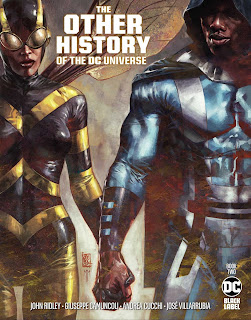I reviewed the first issue of The Other History of the DC Universe back in December but, despite having many of the same traits as the first issue, the second issue has enough differences to warrant addressing on its own, I feel.
Many of the same caveats that I applied to my previous review are still appropriate here. I never read the original History of the DC Universe which is the namesake of this book, nor have I read the "History of the DCU" backup features from 52. Second, I haven't read any DC books with any regularity since maybe 2007, so I'm not exactly up to speed on what's considered canon or not these days and I know almost nothing about either
Vox/Guardian/Hornblower/Herald or Bumblebee, who are the subjects of this issue.
Similar to the previous issue, this one only covers 1970-1989, shortly after Mal (Vox) and Karen (Bumblebee) retire from superheroics. Here again, with writer John Ridley limiting the time-frame to only a couple decades means the characters can age in real time and reasonably align the comic stories with real world events. (Which is a little more critical here than before, as I'll get to in a moment.) The issue hits on various hallmarks of the DC Universe, particularly focusing on events involving the Teen Titans, and places them squarely within the contextual perspective of the two main characters. And to ensure there's no question about what stories might be obliquely referenced, artists Giuseppe Camuncoli, Andrea Cucchi, and Jose Villarrubia homage a number of classic images from DC's past. Though, as before, the issue relies entirely on narration and comes across more as illustrated prose than comics.
Now, some differences. First, and most obviously, with two characters to focus on here, there's more of a dialogue going on. It's not casual enough to feel like they're talking to one another exactly, but they definitely react to one another's words, so it feels something like a single memoir where they both contributed. It does make it interesting in that they don't always have the same perspective on some events, and it acts as a way to address out-of-character moments in the original stories, basically chalking them up to memory lapses.
The book also starts to address how DC treated its Black characters more directly. In the original stories, Vox debuted in Teen Titans #26 (March 1970) but wasn't known by anything but "Mal" until #44, almost seven full years later. The book brings that up, specifically noting how dismissive that was, whether intentional or not, to only ever be referred to by the one name. It goes on to note how many problems the other Titans had (Speedy's drug addiction is brought up a couple times) but they're generally given a pass, while the one Black guy finds his mistakes are continually lorded over him. More than the first issue, there's a much more direct addressing of the inequities Black characters faced compared to their white counterparts, even going so far as to expressly noting the apparent quota on Black characters in Titans when Cyborg was introduced without ever any mention of Duncan.
One other distinct difference this issue has over the first is the referencing of real world events. Two particular stand-outs are Arthur Ashe's Wimbledon Win Over Jimmy Connors in 1975 -- which is used as an analogy for how Black people have to work twice as hard for half as much -- and the Atlanta Child Murders that took place between 1979 and 1981. This second event aligns with the two characters' initial retirement, and they comment how none of the active superheroes did anything about murders, largely because the children in question were all Black. More implicit is the idea that DC was only addressing "real world issues" (like Speedy's aforementioned drug problem from the 1971 Green Lantern/Greeen Arrow story nearly a decade earlier) when they affected white people; the murder of Black children over several years never rose to the same level of concern.
Where the Black Lightening issue touched on some of the differing perspectives Black people might have had in seeing the evolution of the DC Universe throughout the '70s and '80s, this one is much more direct and explicit. It's not a condemnation of DC's creators (Karen's dialogue includes: "I'm not saying the Titans were trying to make him feel bad on purpose. I'm just telling you how it was.") so much as just getting contemporary audiences to recognize the deficiencies that are present in those stories.
Like I said, I know almost nothing about either of the main characters here. I've read very few (any?) of the comics they've appeared in. But even without that "insider" knowledge and knowing the specifics of all the touchstones they mention, it still very much provides an excellent lens with which to look at all of the DC comics from those two decades.
The Other History of the DC Universe #2 Review
By Sean Kleefeld | Tuesday, February 09, 2021
2 comments







2 comments:
This sounds like something which it's astonishing to think is being published by a big company.
The second issue was more pointed than the first. But you could probably still read these and ignore the meta-commentary, assuming that Ridley really is just talking about the characters themselves. You could use the same blinders people have about police brutality against Black people. But I'm curious to see if Ridley continues that trend over the five issues and if/whether folks higher up the chain catch on.
Post a Comment